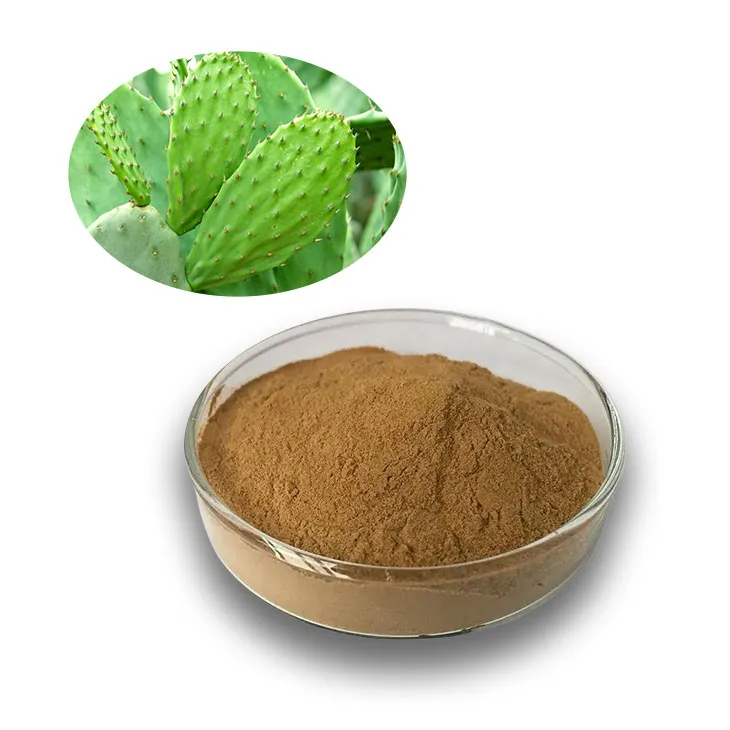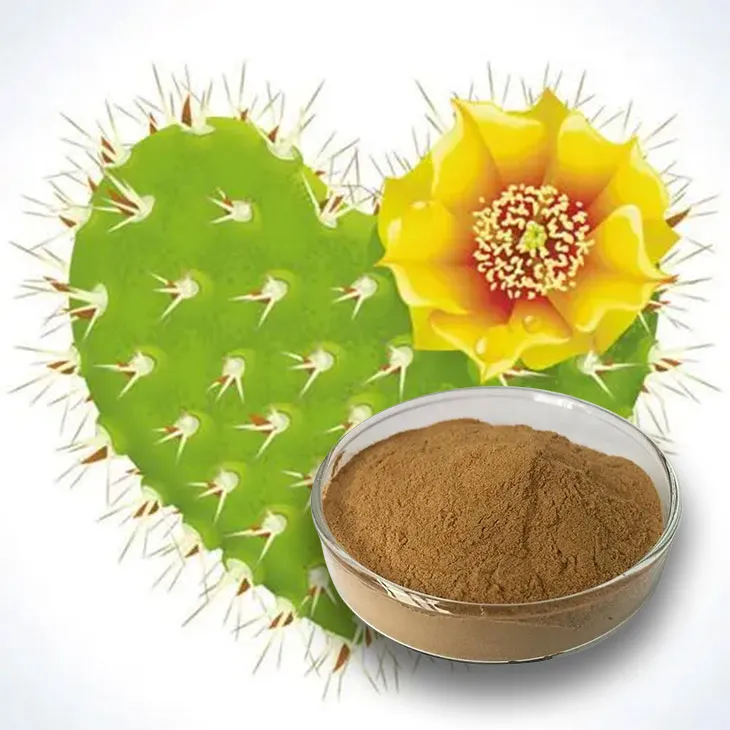- 0086-571-85302990
- sales@greenskybio.com
How to make powder from cactus extract?
2024-11-30

1. Introduction
Cactus Extract has a variety of potential uses, from skincare to traditional medicine. Converting it into powder form can enhance its stability, ease of storage, and versatility. However, it is crucial to approach this process with care, considering both safety and efficiency. This article will guide you through the comprehensive process of making powder from Cactus Extract.

2. Harvesting Cacti
2.1. Selecting the Right Cactus Species
Not all cacti are suitable for extraction. Some common cacti used for their beneficial properties include Opuntia ficus - indica (prickly pear cactus). It is important to identify the correct species accurately to ensure the safety and effectiveness of the extract. Avoid cacti that are protected or endangered species.
2.2. Harvesting Time
The best time to harvest cacti depends on the species. For example, prickly pear cacti are often harvested when the fruits are ripe or the pads are at an appropriate stage of growth. In general, harvesting should be done during the plant's active growth period, which usually occurs in spring or summer. However, it is essential to follow local regulations regarding cactus harvesting.
2.3. Tools and Precautions
When harvesting cacti, you will need proper tools such as thick gloves to protect your hands from the spines, a sharp knife or pruning shears. Handle the cacti carefully to avoid injury to yourself and damage to the plant. If you are harvesting in the wild, make sure you have the necessary permissions.

3. Extracting the Essence
3.1. Cleaning the Cactus
Once harvested, the cactus parts (fruits or pads) need to be thoroughly cleaned. Remove any dirt, debris, or insects. Wash them gently with clean water. For prickly pear fruits, you may need to remove the spines carefully before washing.
3.2. Preparation for Extraction
After cleaning, cut the cactus into small pieces. This will increase the surface area for extraction. For example, if using cactus pads, you can cut them into cubes or slices. If using fruits, you may remove the seeds (if not needed for the extract) and then chop the flesh.
3.3. Extraction Methods
There are several methods for extracting the essence from cactus:
- Solvent Extraction: This involves using a solvent such as ethanol or water. Ethanol is often preferred for its ability to dissolve a wide range of compounds. Place the cut cactus pieces in a container and cover them with the solvent. Let it sit for a period of time, usually several days to a few weeks, depending on the concentration desired. Stir the mixture occasionally. After the extraction period, filter the mixture to separate the liquid extract from the solid plant material.
- Press Extraction: For cacti with a high water content, like prickly pear fruits, press extraction can be used. Use a fruit press or a simple homemade press. Place the cactus pieces in the press and apply pressure to extract the juice. The resulting juice can be further processed.

4. Converting the Extract into Powder
4.1. Evaporation
If the extract is in liquid form (from solvent or press extraction), the first step to convert it into powder is evaporation. You can use a low - heat source such as a water bath or a gentle heat lamp. Place the liquid extract in a shallow dish and heat it gently until most of the liquid has evaporated. Be careful not to overheat, as this may damage the active compounds in the extract.
4.2. Drying
After evaporation, the remaining semi - solid or thick liquid needs to be dried completely. This can be done in a food dehydrator or a low - humidity environment. If using a dehydrator, set it to a low temperature (around 40 - 50°C) to ensure the integrity of the extract. Leave the extract in the dehydrator until it becomes a dry, brittle substance.
4.3. Grinding
Once the extract is completely dry, it can be ground into powder. Use a mortar and pestle for small - scale production or a grinder for larger quantities. Grind the dried extract until it reaches a fine powder consistency. Sieve the powder through a fine - mesh sieve to remove any large particles.
5. Safety Considerations
5.1. Handling Cacti
As mentioned earlier, cacti have spines that can cause injury. Always wear appropriate protective gear when handling them. Some cacti may also cause skin irritation, so if you come into contact with the cactus sap and experience any discomfort, wash the area immediately with soap and water.
5.2. Solvent Safety
If using solvents like ethanol for extraction, handle them with extreme care. Ethanol is flammable, so keep it away from open flames and heat sources. Work in a well - ventilated area to avoid inhaling fumes. Store solvents properly according to safety regulations.
5.3. Quality Control
Ensure that the final powder product is free from contaminants. Test for purity and potency if possible. This is especially important if the powder is intended for use in products such as dietary supplements or skincare.
6. Efficiency Considerations
6.1. Maximizing Yield
To maximize the yield of the Cactus Extract, ensure that the cactus is harvested at the optimal time and prepared properly before extraction. Using the right extraction method for the specific cactus type can also increase the yield. For example, solvent extraction may be more effective for certain compounds, while press extraction may be better for extracting juice.
6.2. Equipment Selection
Selecting the appropriate equipment can improve the efficiency of the process. For small - scale production, simple tools like a mortar and pestle and a basic dehydrator may be sufficient. However, for larger - scale production, more advanced equipment such as industrial - grade grinders and evaporators may be required.
7. Conclusion
Making powder from cactus extract involves several important steps, from harvesting the cacti to the final grinding of the dried extract. By following the proper procedures, considering safety and efficiency, it is possible to produce a high - quality cactus extract powder. Whether for personal use or for commercial production, this powder can be a valuable ingredient in various applications.
FAQ:
Q1: What types of cacti are suitable for extract powder making?
There are several types of cacti that can be considered for extract powder making. Some common ones include Opuntia species. These cacti are often chosen because they are relatively abundant and contain certain bioactive compounds. However, it is crucial to ensure that the cacti are legally harvestable and not endangered species. In addition, different cacti may have different chemical compositions, so the choice may also depend on the intended use of the powder.
Q2: How to harvest cacti properly for extract?
When harvesting cacti for extract, it is important to do it in a sustainable and legal way. First, make sure you have the proper permission if it is on private or protected land. Use clean and sharp tools to cut the cactus parts. For example, if you are harvesting the pads of an Opuntia cactus, cut them cleanly at the base. Try to avoid causing unnecessary damage to the cactus plant as a whole. Also, harvest only what you need and leave enough for the cactus to regrow and survive in its natural environment.
Q3: What are the methods for extracting essence from cactus?
There are several methods for extracting essence from cactus. One common method is solvent extraction. For example, using ethanol as a solvent. The cactus material is crushed or ground first to increase the surface area. Then it is soaked in the solvent for a period of time, usually several hours to days, depending on the specific cactus and the desired concentration. Another method is cold - pressing, which is more suitable for cacti with high water content. This method can directly extract the juice containing the essence without using solvents, but it may require more cactus material to obtain a sufficient amount of essence.
Q4: How to convert the cactus extract into fine powder?
After obtaining the cactus extract, there are different ways to convert it into fine powder. One way is through freeze - drying. In this process, the extract is frozen first, and then the water is removed under vacuum conditions. The resulting dry material can be easily ground into a fine powder. Another method is spray - drying. The extract is sprayed into a hot chamber, where the water evaporates quickly, leaving behind a powder. However, spray - drying may require some additional processing to ensure the powder has the desired particle size and quality.
Q5: What safety precautions should be taken during the process?
During the process of making powder from cactus extract, several safety precautions should be taken. When using solvents for extraction, make sure to work in a well - ventilated area as some solvents can be flammable or toxic. Wear appropriate protective equipment such as gloves and goggles. Also, be careful when handling the cactus as some cacti may have spines that can cause injury. If the cactus is to be consumed in the form of powder, ensure that it has been properly processed and tested for safety, especially to avoid any potential allergic reactions or toxicity from the cacti components.
Related literature
- Cactus Extract: Properties and Potential Applications"
- "Sustainable Harvesting of Cacti for Extract Production"
- "Methods of Cactus Essence Extraction: A Review"
- "Powder Production from Botanical Extracts: Focus on Cacti"
- ▶ Hesperidin
- ▶ citrus bioflavonoids
- ▶ plant extract
- ▶ lycopene
- ▶ Diosmin
- ▶ Grape seed extract
- ▶ Sea buckthorn Juice Powder
- ▶ Beetroot powder
- ▶ Hops Extract
- ▶ Artichoke Extract
- ▶ Reishi mushroom extract
- ▶ Astaxanthin
- ▶ Green Tea Extract
- ▶ Curcumin Extract
- ▶ Horse Chestnut Extract
- ▶ Other Problems
- ▶ Boswellia Serrata Extract
- ▶ Resveratrol Extract
- ▶ Marigold Extract
- ▶ Grape Leaf Extract
- ▶ blog3
- ▶ blog4
-
The best cactus extract on the market.
2024-11-30
-
High - quality lily extract products.
2024-11-30
-
Organic Clove Powder Factory.
2024-11-30
-
Chinese suppliers of chastity berry extract.
2024-11-30
-
Cactus Extract
2024-11-30
-
Epimedium extract powder
2024-11-30
-
Yam Extract
2024-11-30
-
Pine bark Extract Powder
2024-11-30
-
White mustard seed extract
2024-11-30
-
Hawthorn powder
2024-11-30
-
Mango flavored powder
2024-11-30
-
Elderberry Extract
2024-11-30
-
Phellodendron Extract
2024-11-30
-
Saw Palmetto Extract
2024-11-30




















